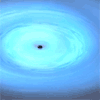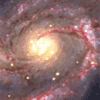CXC Home | Search | Help | Image Use Policy | Latest Images | Privacy | Accessibility | Glossary | Q&A
Animation of Black Hole Formation in SN 1979C
Quicktime MPEG
This animation shows how a black hole may have formed in SN 1979C. The collapse of a massive star is shown, after it has exhausted its fuel. A flash of light from a shock breaking through the surface of the star is then shown, followed by a powerful supernova explosion. The view then zooms into the center of the explosion. Red, slow-moving material in a disk is shown falling onto the white neutron star that formed when the star collapsed. The rate of infall onto the neutron star increases until the star collapses into a black hole. Matter should continue to fall into the black hole and generate bright X-ray emission for many years.
[Runtime: 00:20]
View in HD
Stills:
Quicktime MPEG
This animation shows how a black hole may have formed in SN 1979C. The collapse of a massive star is shown, after it has exhausted its fuel. A flash of light from a shock breaking through the surface of the star is then shown, followed by a powerful supernova explosion. The view then zooms into the center of the explosion. Red, slow-moving material in a disk is shown falling onto the white neutron star that formed when the star collapsed. The rate of infall onto the neutron star increases until the star collapses into a black hole. Matter should continue to fall into the black hole and generate bright X-ray emission for many years.
[Runtime: 00:20]
View in HD
(Credit: NASA/CXC/A.Hobart)
Stills:
Images of Virgo Cluster, M100 and SN 1979C
Quicktime MPEG
This sequence of images begins with a Digitized Sky Survey image showing part of the Virgo Cluster of galaxies. It then zooms into the spiral galaxy M100 located in the top right corner. The Chandra X-ray image of M100 is then shown, with a label for SN 1979C, followed by a composite image that adds in optical data from the Very Large Telescope and infrared data from the Spitzer Space Telescope.
[Runtime: 00:20]
Quicktime MPEG
This sequence of images begins with a Digitized Sky Survey image showing part of the Virgo Cluster of galaxies. It then zooms into the spiral galaxy M100 located in the top right corner. The Chandra X-ray image of M100 is then shown, with a label for SN 1979C, followed by a composite image that adds in optical data from the Very Large Telescope and infrared data from the Spitzer Space Telescope.
[Runtime: 00:20]
(Credit: Widefield Optical: DSS; X-ray: NASA/CXC/SAO/D.Patnaude et al, Optical: ESO/VLT, Infrared: NASA/JPL/Caltech)
A Tour of SN 1979C
Quicktime MPEG
The youngest known black hole in our cosmic neighborhood may have been found using NASA's Chandra X-ray Observatory and other telescopes. Evidence for this very young black hole was found in a supernova called 1979C, seen to explode about 30 years ago. Dr Dan Patnaude of the Harvard-Smithsonian Center for Astrophysics led this study and discusses it with us.
[Runtime: 02:56]
Quicktime MPEG
The youngest known black hole in our cosmic neighborhood may have been found using NASA's Chandra X-ray Observatory and other telescopes. Evidence for this very young black hole was found in a supernova called 1979C, seen to explode about 30 years ago. Dr Dan Patnaude of the Harvard-Smithsonian Center for Astrophysics led this study and discusses it with us.
[Runtime: 02:56]
(Credit: X-ray: NASA/CXC/SAO/D.Patnaude et al, Optical: ESO/VLT, Infrared: NASA/JPL/Caltech)
Return to SN 1979C (November 15, 2010)













